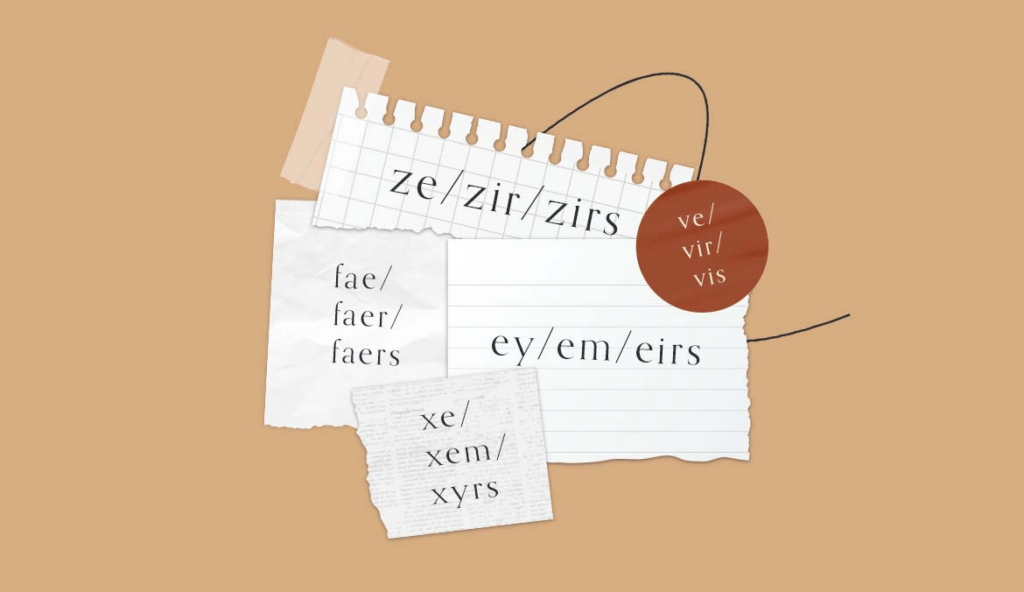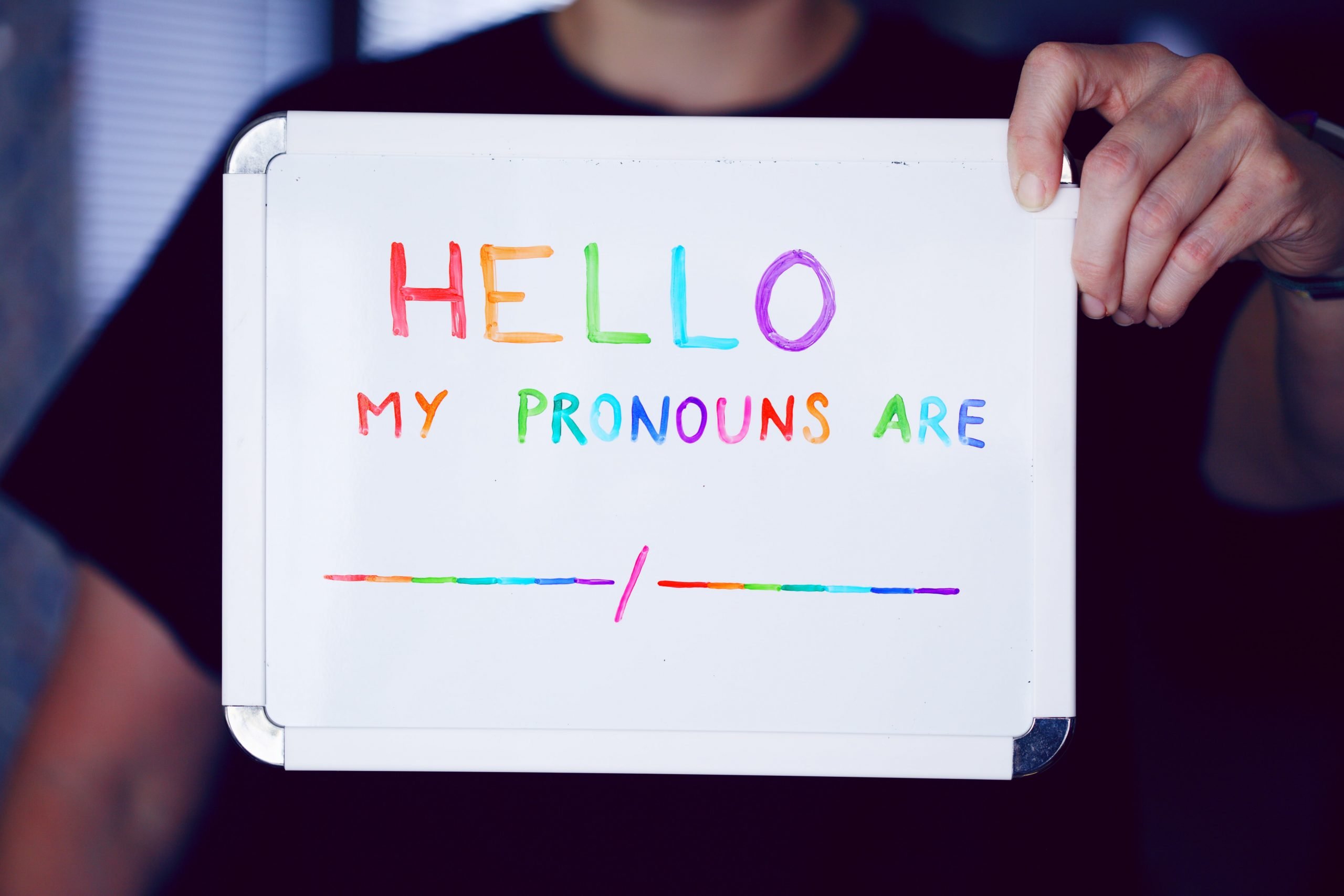Pronouns are words that take the place of a noun to indicate a person, place, or thing. Small sets of words (like she, he, it, we, you, and they) are used to address a person or a group of people. She is an artist; they are partying; he likes to cook; and, of course, as in the song lyrics, Mother Mother sang, “they is my family. They might be crazy, but they is my family.”
We know the plural third-person pronoun, commonly used to refer to a group of people – “They”. It is also a gender-neutral pronoun used by an individual who falls outside the binary of gender. It is crucial to understand that pronouns are not equal to gender. Not everyone who uses they/them pronouns are gender non-conforming.
Moreover, they/them pronouns are also used to refer to a person who wishes to not reveal their gender. Gender-neutral pronouns have been widespread throughout the history of literature and the queer community. But what are neopronouns?
Neopronouns are small sets of words that indicate a person without revealing the gender. Here’s the catch though – all neopronouns are made up. Neopronouns are also called noun-self pronouns or gender-neutral pronouns.
Neo [new] pronouns mean precisely that – new pronouns. An existing word, or a newly made-up word, is drafted into the use of a pronoun. It is open to imagination.

Are made-up pronouns valid?
Language is constantly evolving, and with the increase in awareness and acceptance of gender beyond the conventional binary of “male” and “female,” people are beginning to prefer pronouns that do not box them into a default set of gender roles; and those which help them to adequately express the nuances of their gender identity.
Language changes globally and across various social groups. When slang words like “omg,” “no kid,” and “dope” [the meanings of which did not exist before the early 1800s and that have evolved through a variety of definitions and spellings] are made up and accepted collectively, then why not neopronouns? Although using singular “they” pronouns helped people break out of the gender binaries, they still limited gender identity to three pronoun categories.
Reading about neopronouns the first time can be hard to navigate or possibly overwhelming. But given that we’re constantly learning new words, phrases, and meanings in multiple languages, it is something we can do. Neopronouns will not disappear because they provide value and importance and fill the societal and personal need for gender-neutral pronouns
Stereotypes have also evolved along with the singular “they” pronouns. If gender-nonconforming people do not fit into society’s typical image of androgynous-looking people who sound like men, then they are subtly rejected as a whole. Biological anatomy and gender identity are not the same; their lack of alignment is why we, queer people, exist. Gender non-conforming people do not have to perform their gender to affirm it.
Hex, after coming out as transgender, talked about xir pronouns and how xe came about to use them. Hex wanted to avoid conversations about they/them pronouns because it didn’t feel like the right fit. In the Rolling Stone article, Hex says, “I don’t really vibe with gender at all. I don’t feel like I’m anything. I’m the culmination of my lived experience.” Hex uses xe/xir pronouns after coming across them on Twitter.
Xe said, “In my mind, I had struggled with my identity for so long, and I couldn’t even use they/them for fear of being harassed, and now people are just making it up?” However, after Googling intensely, Hex better understood the usage of neopronouns and liked the idea of ‘made-up’ pronouns. It allowed Hex to feel like xe has both masculine and feminine sides to xir and that xe is embracing the authentic form of self.
Also read: What Are Gender Pronouns And Why Should We Use Them Accurately?

How can a small word represent anybody’s identity?
The Trevor Project, a nonprofit aimed to prevent death by suicide among queer youth, conducted a survey of pronoun usage among young people. It was found in the study that around 25 percent of queer youth use the singular pronoun they/them to refer to themselves, and almost 4 percent said they use a combination of neopronouns like ze/zir or fae/faer.
Reading about neopronouns the first time can be hard to navigate or possibly overwhelming. But given that we’re constantly learning new words, phrases, and meanings in multiple languages, it is something we can do. Neopronouns will not disappear because they provide value and importance and fill the societal and personal need for gender-neutral pronouns.
Neopronouns make queer, gender non-conforming, and trans people comfortable and seen. It allows them the opportunity to put forth their gender expressions. Ultimately, neopronouns exist as a way to be one’s authentic self and create a diverse, inclusive, and accepting world
Our world thrives on innovation and change, so neopronouns or the evolution of new words is not surprising. As a matter of fact, neopronouns existed way back in 1789, when the word “a” was noted to be first used as a personal pronoun [used by a 14th century English writer – John of Trevisa].
Neopronouns are famously used among people who are active in many fandoms. They are also used by people who identify as neurodivergent. Our relationship with gender is unique in its own way, and creating a pronoun for oneself feeds the space and interest to explore the multitude of self-expression without succumbing to a label that does not represent the most authentic self.
Creating a gendered box for every neopronoun is nearly impossible; hence, it gives people the means to exist in various parallels and avoid all its boxes simultaneously.

But how do we know someone’s pronouns?
How do we find out about a person’s pronouns? We ask them. It works the same way for neopronouns as well. Neopronouns users on social media usually mention their pronouns, preferences, and boundaries on their profiles. Carrds are used widely on social media platforms, serving as an identity resume, where the author includes all the information about their pronouns and usage.
The carrd, Neopronouns Guide, explains about neopronouns in detail, including frequently answered questions and misconceptions – also addressing the complaint that neopronouns are made up and are invalid. It addresses the questions by saying that literally every word is made up and that neopronouns are real because people find them meaningful.
Neopronouns are often made fun of by people, and sometimes there is pushback. However, thorough research and an open mind will allow you to dive into a world of freedom, acceptance, and pleasure.
Neopronouns make queer, gender non-conforming, and trans people comfortable and seen. It allows them the opportunity to put forth their gender expressions. Ultimately, neopronouns exist as a way to be one’s authentic self and create a diverse, inclusive, and accepting world.
Also read: The Problematic Universalisation Of The Pronouns ‘He/Him’
Featured Image Source: Rice Media
About the author(s)
Prathyusha [they/them] is a queer writer from Chennai. When they are not reading, they are either baking or buying books




